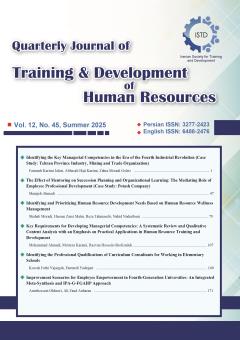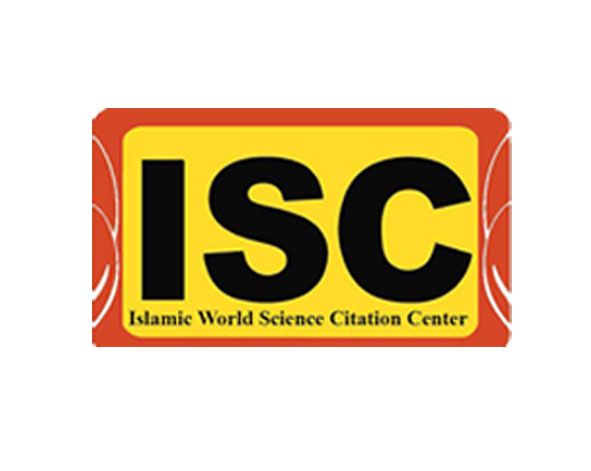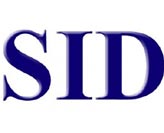About the journal
The Quarterly Journal of Human Resources Training and Development invites thinkers, scholars, experts, professors and university students to send their science research articles to the announced address for publication in order to present the latest theories and scientific findings as well as to exchange innovative ideas in the area of human resources training and development.
Persian ISSN: 2423-3277
English ISSN: 2476-6488
Recent Articles
-
Open Access Article
1 - Identifying the Key Managerial Competencies in the Era of the Fourth Industrial Revolution (Case Study: Tehran Province Industry, Mining and Trade Organization)
Fatemeh Karimi Jafari * ، AbbasAli HajiKarimi ، Zahra Moradi GolrizIssue 45 , Vol. 12 , Summer 2025 -
Open Access Article
2 - The Effect of Mentoring on Succession Planning and Organizational Learning: The Mediating Role of Employee Professional Development (Case Study: Potash Company)
Manijeh Ahmadi *Issue 45 , Vol. 12 , Summer 2025 -
Open Access Article
3 - Identifying and Prioritizing Human Resource Development Needs Based on Human Resource Wellness Management
Shahab Moradi * ، Hassan Zareei Matin ، reza tahmasbi ، Nahid NaderibeniIssue 45 , Vol. 12 , Summer 2025 -
Open Access Article
4 - Key Requirements for Developing Managerial Competencies: A Systematic Review and Qualitative Content Analysis with an Emphasis on Practical Applications in Human Resource Training and Development
Mohammad Ahmadi ، مرتضی کرمی * ، Razvan HosseingholizadehIssue 45 , Vol. 12 , Summer 2025 -
Open Access Article
5 - Identifying the Professional Qualifications of Curriculum Consultants for Working in Elementary Schools
Kurosh Fathi Vajargah * ، Fateme YadegariIssue 45 , Vol. 12 , Summer 2025 -
Open Access Article
6 - Improvement Scenarios for Employee Empowerment in Fourth-Generation Universities: An Integrated Meta-Synthesis and IPA-G-FGAHP Approach
Amirhosein okhravi * ، Ali ZandanbaranIssue 45 , Vol. 12 , Summer 2025
Most Viewed Articles
-
Open Access Article
1 - A Pathology and Effectiveness of the Transfer of Training to Workplace
Gholamreza Shams Morkani * ، Hamed Abbasi kasaniIssue 13 , Vol. 4 , Summer 2017 -
Open Access Article
2 - Identifying Talent Development Mechanisms in Iranian Electric Industry
کریم شاطری * ، Khodayar Abili ، علی رضاییان ، Aryan gholipourIssue 7 , Vol. 2 , Winter 2016 -
Open Access Article
3 - Studying the Challenges of Training and Development of Human Resources Based on Three Branches Model
gholamreza shams mourkani * ، علی فاطمی صفتIssue 7 , Vol. 2 , Winter 2016 -
Open Access Article
4 - Presentation Leaders' Self-Development Model: A Synthesis of Research
mahdi sahraei beiranvand ، Gholamreza Shams Morkani * ، Abasalt Khorasani ، Mohammad sadegh Khayatian yazdiIssue 28 , Vol. 8 , Spring 2021 -
Open Access Article
5 - Designing Talent Management Model in Banking Industry
allahvirdi habibpoor ، Arian Gholipour * ، Gholamreza MemarzadehIssue 19 , Vol. 5 , Winter 2019 -
Open Access Article
6 - Identifying and Modelling of Challenges for Implementing E-Learning in the Iranian National Gas Company: An Interpretive Structural Modeling (ISM) approach
farzane tari * ، غلامرضا شمس مورکانیIssue 14 , Vol. 4 , Autumn 2017 -
Open Access Article
7 - identifying the critical success factors for coaching in organizations with a meta-synthesis approach: providing a model
Sajad Gharloghi ، Abasalt Khorasani * ، Gholamreza Shams Moorkani ، Behrooz GhelichleeIssue 26 , Vol. 7 , Autumn 2020 -
Open Access Article
8 - Pathology of Human Resource Training System in Higher Education: Codification and Validation of a Model
Khaled Mirahmadi ، Abasalt Khorasani ، Mohammad taghi Nazarpour * ، Gholamreza Shams MurkaniIssue 28 , Vol. 8 , Spring 2021 -
Open Access Article
9 - Studying the Challenges in the Transfer of Learning to Workplace in Public Organizations of Kurdistan Province (A Qualitative Research)
Sirous Ghanbari ، gholamreza shams mourkani ، mahboobeh arefi ، khalil zandi *Issue 12 , Vol. 4 , Spring 2017 -
Open Access Article
10 - Studying the Effect of in Service Training on the Level of Human Resource Empowerment: Case Study of Institutions in the Defense Industry
اباصلت خراسانی ، علیرضا جوانبخت * ، سید شمس الدین چاوشیIssue 9 , Vol. 3 , Summer 2016









